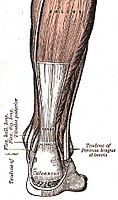
Photo from wikipedia
Abstract The manuscript presents a novel reduced order homogenization model for oxidation-assisted rupture in SiC/SiC composites at intermediate temperatures. Starting with a one-dimensional model based on the slow crack growth… Click to show full abstract
Abstract The manuscript presents a novel reduced order homogenization model for oxidation-assisted rupture in SiC/SiC composites at intermediate temperatures. Starting with a one-dimensional model based on the slow crack growth model originally proposed by Iyengar and Curtin, which is subsequently generalized to three dimensions focusing on the woven composite architecture. The proposed oxidation-assisted rupture model is developed within the framework of continuum damage mechanics where the constitutive equation in the axial tow direction is governed by the continuum damage mechanics variant of the slow crack-growth model and the availability of oxygen to fibers, which in turn depends on the initial matrix pores and subsequent matrix cracking. The constitutive model in the transverse tow directions as well as in the matrix phase outside the tows is assumed to obey a time-independent orthotropic continuum damage mechanics model, but the time-dependent nature of the axial tow model, inevitably causes the time-dependent redistribution of damage in all directions and phases. The reduced order homogenization approach that provides an efficient framework for computing overall composite behavior is employed for model reduction. Numerical validation studies are conducted on the eight-harness weave architecture.
Journal Title: International Journal of Solids and Structures
Year Published: 2020
Link to full text (if available)
Share on Social Media: Sign Up to like & get
recommendations!